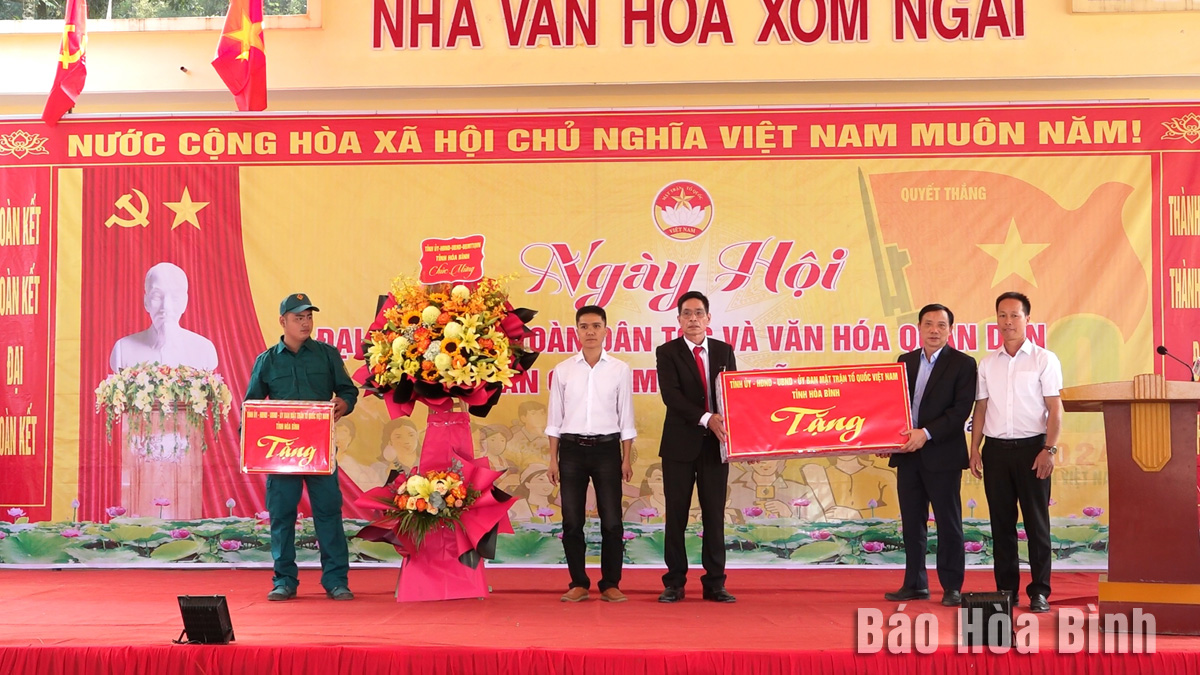
A great national solidarity festival was held in Ngai hamlet, Thach Yen commune, Cao Phong district, on November 8. Deputy Secretary of the Party Committee and Chairman of the People’s Committee of Hoa Binh province Bui Van Khanh, and Colonel Trinh Duc Thiem, Commander of the provincial Military Command, attended the event.

Vice
Secretary of the Party Committee and Chairman of the People’s Committee of Hoa
Binh province Bui Van Khanh presents flowers and gifts to representatives of
residential area.
Photo: Colonel Trinh Duc Thiem, Commander of the
provincial Military Command, presents gifts to representatives of residential
area.
Ngai hamlet is home to 89 households with 428
people, 95% of them Muong ethnic minority people. Residents in the hamlet
always actively respond to emulation movements and campaigns, especially the
one "All people unite to build new rural areas and promote urban
civilization". They stay united and work hard to overcome difficulties,
contributing to promoting socio-economic development, and building the
residential areas with development in all aspects.
The per capita income in the hamlet is 35
million VND (1,381 USD) per year. The rate of poor households decreased to
9.8%. Up to 92% of the households in the residential area obtained
the title of "Family of culture”.
Speaking at the event, Khanh praised the
residential area for its achievements, expressing his hope that local people
will continue to promote solidarity, will, aspiration, and creative emulation
spirit to join efforts to build the homeland.
He requested the local Party Committee,
administration, and Vietnam Fatherland Front Committee to continue popularising
and calling on people to well implement the Party's guidelines and policies,
and the State's laws; and mobilising all resources to promote the
implementation of the Party Congress resolutions at all levels.
On the occasion, the residential area of the
hamlet received gifts of the provincial Party Committee, People’s Committee,
and Vietnam Fatherland Front Committee of Hoa Binh province, and local sectors.
As a land deeply intertwined with human history and Vietnam’s millennia-long journey of nation-building and defence, Hoa Binh is often revered for its epic tales and legends.
Residents of Hoa Binh boast a rich cultural identity, reflected in their unique language, traditional attire, customs, and folk melodies – described as "sweet as honey, clear as a mountain stream.”
Lac Son district’s Vu ban town held the 2025 Truong Kha temple festival on April 12–13 (the 15th–16th days of the third lunar month). Since its revival in 2019, the festival has been organised every three years, preserving valuable intangible heritage while meeting the community’s cultural and spiritual needs.
The clothing of women reflects the culture of the Muong, Thai, Tay, Dao, and Mong ethnic groups in the northern province of Hoa Binh.
Gongs hold a special place in the cultural and spiritual life of the Muong ethnic people in Hoa Binh province. More than musical instruments, they are an indispensable part of community rituals and collective memory, echoing through generations as a spiritual thread linking the past, present, and future.
Preserving and promoting the cultural values of the Muong ethnic group has become an urgent task in the current context, as many traditional values face the risk of fading away. This effort requires not only protecting the cultural identity but also eliminating outdated customs and developing a modern cultural lifestyle, contributing to sustainable values for the Muong community in Hoa Binh province.
The Muong ethnic culture, deeply rooted in Vietnam’s mountainous north, continues to be preserved and revitalised by dedicated individuals and communities determined to safeguard their ancestral identity.



